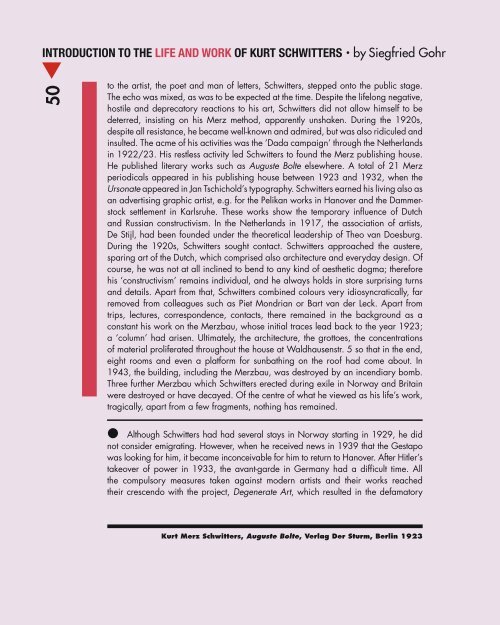Kurt Schwitters: Merz (2016) – Norman Rosenthal interviews Damien Hirst
Fully illustrated catalog published by Galerie Gmurzynska in collaboration with Cabaret Voltaire Zurich on the occasion of Kurt Schwitters: MERZ, a major retrospective exhibition celebrating 100 years of Dada. The exhibition builds and expands on the gallery’s five decade long exhibition history with the artist, featuring exhibition architecture by Zaha Hadid. Edited by Krystyna Gmurzynska and Mathias Rastorfer. First of three planned volumes containing original writings by Kurt Schwitters, historical essays by Ernst Schwitters, Ad Reinhardt and Werner Schmalenbach as well as text contributions by Siegfried Gohr, Adrian Notz, Jonathan Fineberg, Karin Orchard, and Flavin Judd. Foreword by Krystyna Gmurzynska and Mathias Rastorfer. Interview with Damien Hirst conducted by Norman Rosenthal. Includes full color plates and archival photographs. 174 pages, color and b/w illustrations. English. ISBN: 978-3-905792-33-1 The publication includes an Interview with Damien Hirst by Sir Norman Rosenthal about the importance of Kurt Schwitters's practice for Hirst's work.
Fully illustrated catalog published by Galerie Gmurzynska in collaboration with Cabaret Voltaire Zurich on the occasion of Kurt Schwitters: MERZ, a major retrospective exhibition celebrating 100 years of Dada. The exhibition builds and expands on the gallery’s five decade long exhibition history with the artist, featuring exhibition architecture by Zaha Hadid.
Edited by Krystyna Gmurzynska and Mathias Rastorfer.
First of three planned volumes containing original writings by Kurt Schwitters, historical essays by Ernst Schwitters, Ad Reinhardt and Werner Schmalenbach as well as text contributions by Siegfried Gohr, Adrian Notz, Jonathan Fineberg, Karin Orchard, and Flavin Judd.
Foreword by Krystyna Gmurzynska and Mathias Rastorfer.
Interview with Damien Hirst conducted by Norman Rosenthal.
Includes full color plates and archival photographs.
174 pages, color and b/w illustrations.
English.
ISBN:
978-3-905792-33-1
The publication includes an Interview with Damien Hirst by Sir Norman Rosenthal about the importance of Kurt Schwitters's practice for Hirst's work.
You also want an ePaper? Increase the reach of your titles
YUMPU automatically turns print PDFs into web optimized ePapers that Google loves.
INTRODUCTION TO THE LIFE AND WORK OF KURT SCHWITTERS · by Siegfried Gohr<br />
t<br />
50<br />
to the artist, the poet and man of letters, <strong>Schwitters</strong>, stepped onto the public stage.<br />
The echo was mixed, as was to be expected at the time. Despite the lifelong negative,<br />
hostile and deprecatory reactions to his art, <strong>Schwitters</strong> did not allow himself to be<br />
deterred, insisting on his <strong>Merz</strong> method, apparently unshaken. During the 1920s,<br />
despite all resistance, he became well-known and admired, but was also ridiculed and<br />
insulted. The acme of his activities was the ‘Dada campaign’ through the Netherlands<br />
in 1922/23. His restless activity led <strong>Schwitters</strong> to found the <strong>Merz</strong> publishing house.<br />
He published literary works such as Auguste Bolte elsewhere. A total of 21 <strong>Merz</strong><br />
periodicals appeared in his publishing house between 1923 and 1932, when the<br />
Ursonate appeared in Jan Tschichold’s typography. <strong>Schwitters</strong> earned his living also as<br />
an advertising graphic artist, e.g. for the Pelikan works in Hanover and the Dammerstock<br />
settlement in Karlsruhe. These works show the temporary influence of Dutch<br />
and Russian constructivism. In the Netherlands in 1917, the association of artists,<br />
De Stijl, had been founded under the theoretical leadership of Theo van Doesburg.<br />
During the 1920s, <strong>Schwitters</strong> sought contact. <strong>Schwitters</strong> approached the austere,<br />
sparing art of the Dutch, which comprised also architecture and everyday design. Of<br />
course, he was not at all inclined to bend to any kind of aesthetic dogma; therefore<br />
his ‘constructivism’ remains individual, and he always holds in store surprising turns<br />
and details. Apart from that, <strong>Schwitters</strong> combined colours very idiosyncratically, far<br />
removed from colleagues such as Piet Mondrian or Bart van der Leck. Apart from<br />
trips, lectures, correspondence, contacts, there remained in the background as a<br />
constant his work on the <strong>Merz</strong>bau, whose initial traces lead back to the year 1923;<br />
a ‘column’ had arisen. Ultimately, the architecture, the grottoes, the concentrations<br />
of material proliferated throughout the house at Waldhausenstr. 5 so that in the end,<br />
eight rooms and even a platform for sunbathing on the roof had come about. In<br />
1943, the building, including the <strong>Merz</strong>bau, was destroyed by an incendiary bomb.<br />
Three further <strong>Merz</strong>bau which <strong>Schwitters</strong> erected during exile in Norway and Britain<br />
were destroyed or have decayed. Of the centre of what he viewed as his life’s work,<br />
tragically, apart from a few fragments, nothing has remained.<br />
•<br />
Although <strong>Schwitters</strong> had had several stays in Norway starting in 1929, he did<br />
not consider emigrating. However, when he received news in 1939 that the Gestapo<br />
was looking for him, it became inconceivable for him to return to Hanover. After Hitler’s<br />
takeover of power in 1933, the avant-garde in Germany had a difficult time. All<br />
the compulsory measures taken against modern artists and their works reached<br />
their crescendo with the project, Degenerate Art, which resulted in the defamatory<br />
<strong>Kurt</strong> <strong>Merz</strong> <strong>Schwitters</strong>, Auguste Bolte, Verlag Der Sturm, Berlin 1923

















